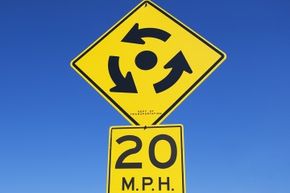Tips for Driving a Roundabout
We get it: Roundabouts can be a little intimidating when you approach one for the first time. Nobody wants to mess up and cause an accident. Thankfully, cars, trucks, cyclists and pedestrians can all make it through safely by following a few simple rules.
As you approach a roundabout in your car, you'll notice a yellow, diamond-shaped sign with a circle of arrows denoting the roundabout ahead. It will also have suggested speed, usually around 20 to 30 miles per hour (32 to 48 kilometers per hour). Slow to that speed and look for pedestrians in the crosswalk. If the walk is clear, continue to the yield sign, checking to your left for any traffic in the circular roadway. If it's occupied, stop at the dashed yield line; otherwise, you're good to enter the roundabout.
Advertisement
Now you have the right-of-way, so don't stop. Not only will you disrupt the flow of traffic, but other drivers will probably let you know about it with their horn or other, well, gestures. Once you reach your chosen exit, signal to indicate your intention to turn and check again for pedestrians. The only thing that should stop you now is if the crosswalk is occupied.
Two-lane roundabouts require a couple of additional pointers. Upon approaching one of these, you'll also see a sign to help you choose your lane. In a typical four-leg roundabout, you'll want to be in the right lane to turn right or go straight, and in the left lane to go straight, turn left or make a U-turn. Once in the roundabout, don't change lanes or overtake a vehicle or cyclist in the lane beside you. Don't travel next to large commercial trucks, either: They may need to use both lanes to make it around the circle [sources: WSDOT, "How to Drive" and NDOT, "Driving"].
When cycling you should exercise care as well, whether you choose to ride though a roundabout like a car or pull over and walk it like a pedestrian. If you decide to ride, occupy the center of the lane in order to discourage cars from passing you, and don't forget to signal before you exit. If that's a little too much action for you, you're welcome to use the crosswalk; just make sure you get off your bike and walk it like a pedestrian.
Speaking of pedestrians, they also have a role to play in crosswalk safety. When walking through a roundabout, never cross the circular roadway. Instead, cross the legs about one vehicle-length from the circle, preferably at a crosswalk. Even though you have the right-of-way, make sure drivers see you before you step out into the road. If you need to, use the splitter islands for refuge [source: NDOT, "Driving"].
Author's Note: How Roundabouts Work
Count me among the drivers once skeptical of roundabouts. It all started on a trip to New Zealand with my grandparents, who rented a car to drive – on the left side of the road – across the countryside. With me in the navigator's seat, things were going surprisingly well until we encountered a multi-lane roundabout. I froze, hopelessly confused in the web of legs that seemed to branch off in 20 different directions. We drove around and around and around, weaving in and out of traffic until we finally managed to exit and find a pull off where we could reorient ourselves. Of course, that was 15 years ago and I had little experience with roundabouts in the United States. Now there are several in my community, and I've grown quite fond of them. And, as writing this article has shown me, the more you think about them, the more sense they make. So embrace the roundabout!
Related Articles
More Great Links
Sources
- Federal Highway Administration. "Roundabouts: An Informational Guide." June 2000. (Dec. 5, 2016) https://www.fhwa.dot.gov/publications/research/safety/00067/00067.pdf
- Federal Highway Administration, "Roundabouts." April 13, 2014. (Dec. 11, 2016) http://www.fhwa.dot.gov/research/deployment/roundabouts.cfm
- Guinness World Records. "Largest Roundabout." Bantam Books. 2013. (Dec. 10, 2016) https://books.google.com/books?id=N2ExOXxw6cAC
- Insurance Institute for Highway Safety. "Even Skeptical Drivers End Up Being Fans of Roundabouts." July 28, 2001. (Dec. 7, 2016) http://www.iihs.org/iihs/sr/statusreport/article/36/7/2
- Lewis, Olivia. "Carmel Man Seeks World Record for Time Spent Driving in a Roundabout." Indianapolis Star. Nov. 6, 2015. (Dec. 9, 2016) http://www.indystar.com/story/news/2015/11/06/carmel-man-seeks-world-record-roundabout/75223336/
- Marshall, Aarian. "The Brilliant Sorcery of England's 7-Circle Magic Roundabout." Wired. Aug. 3, 2016. (Dec. 10, 2016) https://www.wired.com/2016/08/brilliant-sorcery-englands-7-circle-magic-roundabout/
- Metcalfe, John. "Why Does America Hate Roundabouts?" CityLab. March 10, 2016. (Dec. 8, 2016) http://www.citylab.com/commute/2016/03/america-traffic-roundabouts-street-map/408598/
- National Motorists Association. "Is It the 'Golden Age' for Roundabouts?" NMA E-newsletter No. 367. Jan. 24, 2016. (Dec. 9, 2016) https://www.motorists.org/alerts/is-it-the-golden-age-for-roundabouts-nma-e-newsletter-367/
- Nevada Department of Transportation. "Driving in a Roundabout." 2015. (Dec. 6, 2016) https://www.nevadadot.com/safety/roundabout/driving.aspx
- Nevada Department of Transportation. "Roundabout Benefits." 2015. (Dec. 6, 2016) https://www.nevadadot.com/safety/roundabout/benefits.aspx
- Waddell, Edmund. "Evolution of Roundabout Technology: A History-Based Literature Review." (Dec. 8, 2016) http://www.k-state.edu/roundabouts/research/Waddell.pdf
- Washington State Department of Transportation. "How to Drive a Roundabout." 2016. (Dec. 5, 2016) https://www.wsdot.wa.gov/Safety/roundabouts/default.htm
- Washington State Department of Transportation. "Roundabout Benefits." 2016. (Dec. 7, 2016) https://www.wsdot.wa.gov/Safety/roundabouts/benefits.htm
